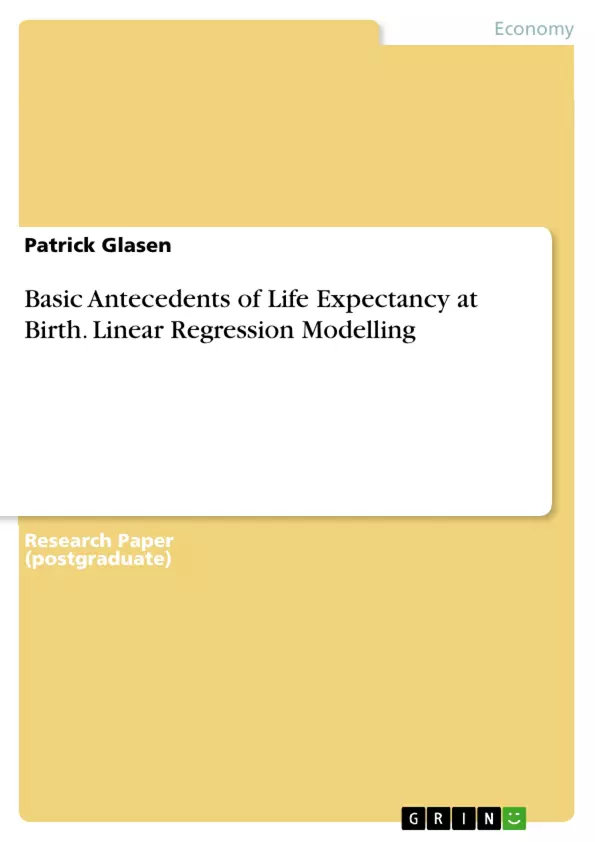This paper uses basic educational and health-related factors as antecedents for life expectancy at birth on country level. Life expectancy is a highly complicated construct and varies strongly with respect to national borders. Aiming to provide a prediction model, prognoses are based on health expenditure per capita, HIV prevalence, immunization rates and literacy rates and justify cross-national dissimilarities in expected lifetime in a simple manner. The model helps to estimate the importance of the used antecedents among each other and gives a basic understanding on how life expectancy could potentially be influenced. Due to the usage of basic antecedents, the highlighted potential will be of special interest for developing countries.
Inhaltsverzeichnis (Table of Contents)
- Introduction
- Population and Sample
- Variables
- Methodology
- Analysis of Results
- Discussion
- Conclusion
Zielsetzung und Themenschwerpunkte (Objectives and Key Themes)
This paper examines the relationship between basic educational and health-related factors and life expectancy at birth on a country level. The study aims to develop a prediction model for life expectancy based on health expenditure per capita, HIV prevalence, immunization rates, and literacy rates. The model seeks to explain cross-national variations in life expectancy and identify the relative importance of the included antecedents.
- Life expectancy at birth as a complex phenomenon influenced by various factors
- Identifying key antecedents of life expectancy, particularly in developing countries
- Developing a prediction model for life expectancy based on selected factors
- Assessing the relative importance of the identified antecedents
- Understanding how life expectancy can be potentially influenced by these factors
Zusammenfassung der Kapitel (Chapter Summaries)
- Introduction: The chapter provides an overview of existing research on life expectancy and its determinants, focusing on cross-national disparities and the impact of social and economic factors. The importance of life expectancy as a valuable asset is highlighted, and key findings from previous research are presented, including the influence of illiteracy, income disparity, social class, and gender on life expectancy.
- Population and Sample: This chapter describes the population and sample used in the study, providing details about the specific countries and data sources employed. The chapter may also discuss any limitations or biases related to the sample selection.
- Variables: This chapter introduces the variables used in the study, including the dependent variable (life expectancy at birth) and independent variables (health expenditure per capita, HIV prevalence, immunization rates, and literacy rates). The chapter will likely define each variable and explain its relevance to life expectancy.
- Methodology: This chapter outlines the methodological approach used in the study, including the statistical methods employed to analyze the relationship between the variables. The chapter might detail the specific regression model used and explain the rationale for its selection.
- Analysis of Results: This chapter presents the results of the statistical analysis, focusing on the relationship between the independent variables and life expectancy. The chapter might include tables, graphs, and descriptive statistics to illustrate the findings and highlight significant relationships.
Schlüsselwörter (Keywords)
The main keywords and focus topics of this study include life expectancy, linear model, health expenditure, HIV prevalence, immunization rates, literacy rates, and developing countries. These terms represent the core concepts and research focus of the paper, encompassing the antecedents and determinants of life expectancy, particularly in the context of less developed nations.
- Citar trabajo
- Patrick Glasen (Autor), 2015, Basic Antecedents of Life Expectancy at Birth. Linear Regression Modelling, Múnich, GRIN Verlag, https://www.grin.com/document/311417



